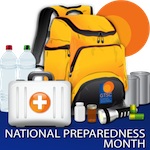
When the Floodwaters Recede, Will Your Business Be Afloat?
 September 2013 is National Preparedness Month. Over the next month, the GTSC blog will take a look at some emergency tips and resources to keep your business prepared to be ‘afloat’ for the inevitable.
September 2013 is National Preparedness Month. Over the next month, the GTSC blog will take a look at some emergency tips and resources to keep your business prepared to be ‘afloat’ for the inevitable.
In May, states across the US experienced major flooding and record-breaking tornadoes plowed through cities and towns. In June, wildfires devastated Arizona. In April, newspapers and news channels were consumed with the Boston bombing. In every case, local businesses were impacted – and in some cases destroyed – in the aftermath of the disaster.
With disasters—manmade and natural—on the rise worldwide, and local businesses increasingly impacted by what happens around the globe as much as what happens down the street, business continuity planning is more important than ever.
Some Businesses Won’t Survive
Local businesses are the economic backbone of their communities. When they have no plan to guide recovery efforts after a disaster, the effects of lost wages and services ripple through the entire community, and the impacts keep piling up after the crisis.
Following a major disaster, local businesses that aren’t prepared continue to suffer. According to a study by the Institute for Business & Home Safety, 25% of local businesses never reopen. For those that do, reopening quickly is essential to survival. More than 80% of businesses that take more than 10 days to resume operations will close within one month.
Some Businesses Will Thrive
Nobody would hope for a disaster to boost the local economy, but experience shows that they often do. The effect is so significant that local economies are often overrun by outside businesses seeking to get their hands on valuable contracts. Often, these companies bring in their own outside workers that have no ties to the community. If your business can weather the storm, it will help your bottom line and benefit local workers and families.
Preparation is Key
Business continuity planning can help your business weather the storm—or anything else that comes along. The basic steps are relatively easy, but many businesses never get around to thinking about them until it’s too late.
- Identify key stakeholders.
- Prioritize critical functions.
- Plan to restore functions following a disaster. Consider the following:
- Establish orders of succession
- Develop crisis communication plans
- Design an IT disaster recovery plan
- Define organizational roles & responsibilities that will take effect during the disruption
Benefits Beyond Survival
As you develop a business continuity plan, you’ll take a closer look at your organization and its priorities. Often, stakeholders uncover ways to streamline or improve operations as a byproduct of disaster planning.
Disasters may be devastating, but planning is good for business. Get started today!

Lilly Harris
CEO
Man-Machine Systems Assessment
Lilly Harris is the President and CEO of Man-Machine Systems Assessment. MSA is an Economically Disadvantaged Woman-Owned Small Business with 23 years of government contracting experience. MSA is passionate about our Warfighters and the preparedness of our nation. MSA works diligently to evaluate defense systems, ensure continuity of operations and support mission critical programs that are aligned with our passion and mission.
Visit: www.msaincorp.com
Follow: @MSAincorp

